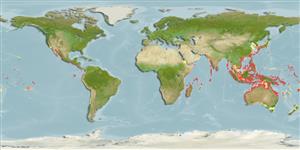Common names from other countries
Environment: milieu / climate zone / depth range / distribution range
Écologie
marin; saumâtre récifal; profondeur 5 - 40 m (Ref. 90102), usually 12 - 20 m (Ref. 27115). Tropical; 24°C - 27°C (Ref. 27115)
Western Indian Ocean: Maldives (Ref. 30829). Western Pacific.
Taille / Poids / Âge
Maturity: Lm ? range ? - ? cm
Max length : 12.5 cm TL mâle / non sexé; (Ref. 2334)
Épines dorsales (Total) : 10; Rayons mous dorsaux (Total) : 12; Épines anales: 3; Rayons mous anaux: 6. Resemble C. oxycephalus but lacks spots on the tail and has a conspicuous opercular ocellus (Ref. 37816).
A common species found in rocky and coral areas of subtidal coastal reefs (Ref. 9710). Enters shallow harbors and estuaries (Ref. 48636). Solitary or in small groups (Ref 90102).
Life cycle and mating behavior
Maturities | Reproduction | Spawnings | Egg(s) | Fecundities | Larves
Pelagic spawner (Ref. 31569). Spawning ascents into the water column occurred over a distance of 0.3 to 0.6 m (Ref. 26305).
Randall, J.E., G.R. Allen and R.C. Steene, 1990. Fishes of the Great Barrier Reef and Coral Sea. University of Hawaii Press, Honolulu, Hawaii. 506 p. (Ref. 2334)
Statut dans la liste rouge de l'IUCN (Ref. 130435)
CITES (Ref. 128078)
Not Evaluated
Menace pour l'homme
Harmless
Utilisations par l'homme
Pêcheries: pêcheries vivrières; Aquarium: Commercial
Outils
Articles particuliers
Télécharger en XML
Sources Internet
Estimates based on models
Preferred temperature (Ref.
115969): 22.4 - 28.9, mean 27.6 (based on 338 cells).
Phylogenetic diversity index (Ref.
82804): PD
50 = 0.5039 [Uniqueness, from 0.5 = low to 2.0 = high].
Bayesian length-weight: a=0.01585 (0.00637 - 0.03944), b=3.01 (2.79 - 3.23), in cm Total Length, based on LWR estimates for this (Sub)family-body shape (Ref.
93245).
Niveau trophique (Ref.
69278): 3.5 ±0.55 se; based on food items.
Fishing Vulnerability (Ref.
59153): Low vulnerability (10 of 100).
